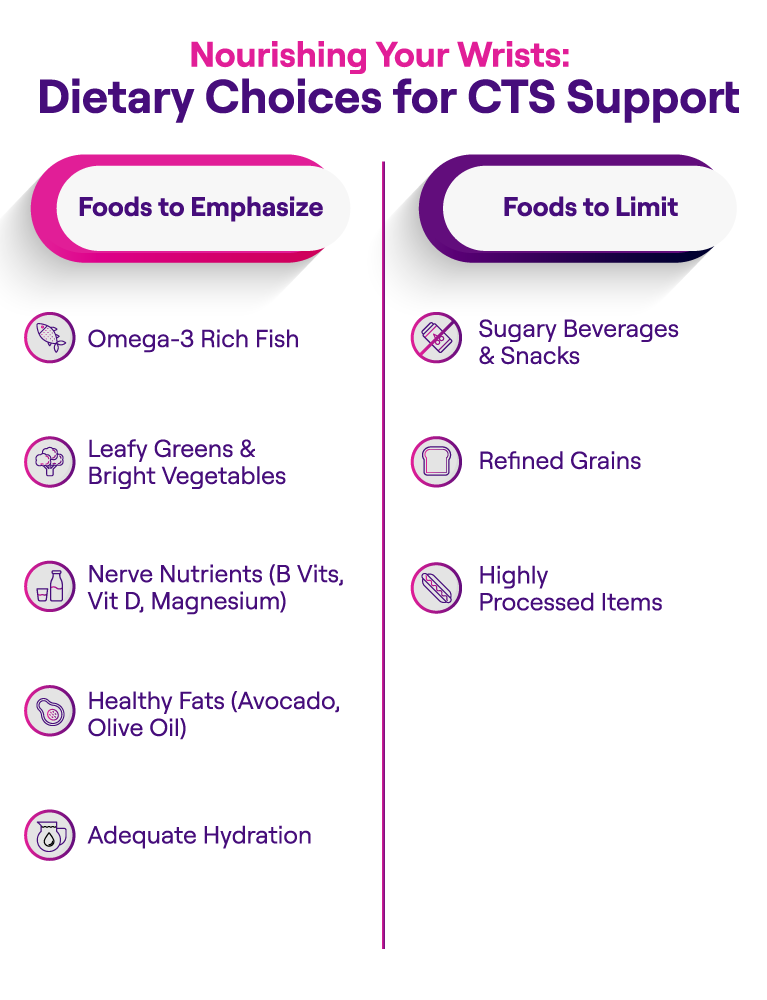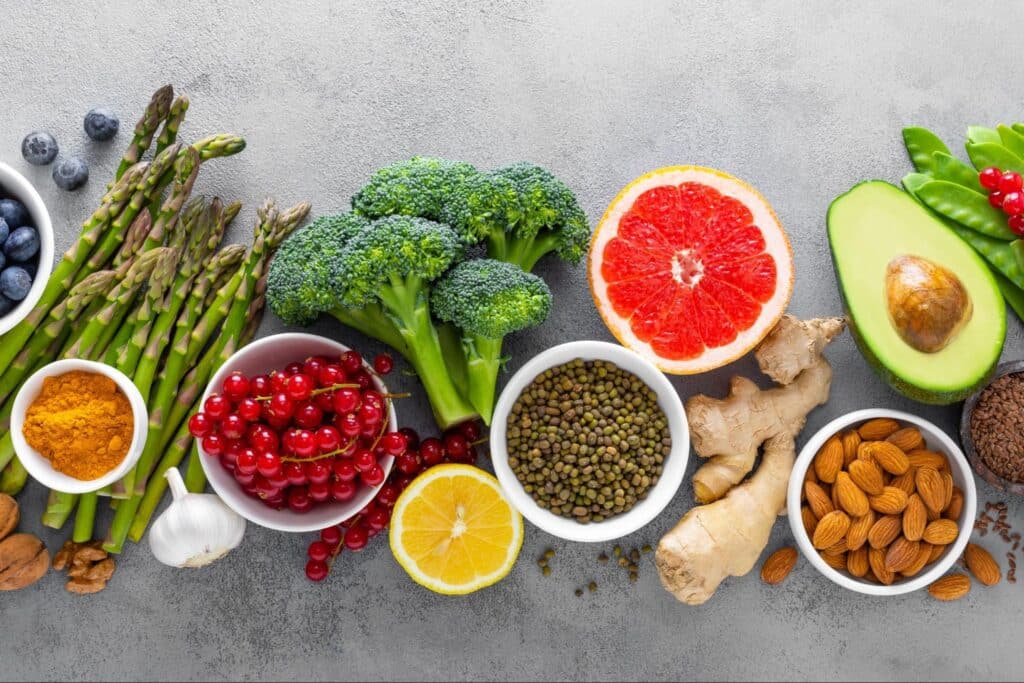Living with carpal tunnel syndrome (CTS) can make everyday activities feel challenging, with symptoms like pain, numbness, and tingling disrupting your routine. While medical interventions and ergonomic adjustments are commonly used to address CTS, few people realize the potential impact of diet on this condition. Incorporating thoughtful dietary changes may help the body manage inflammation, support nerve health, and enhance overall wellness. Although diet alone will not correct the structural issues underlying CTS, it can serve as part of a broader management plan that includes professional guidance and lifestyle improvements.
This article explores the connection between diet and CTS management, offering practical advice on how anti-inflammatory foods and nerve-supporting nutrients might ease discomfort. We also discuss the importance of hydration, identify foods that could worsen symptoms, and highlight how diet complements other measures such as ergonomic adjustments or medical options including carpal tunnel release with ultrasound guidance (CTR-US). By understanding how nutrition fits into CTS care, individuals may feel more empowered to find relief and improve their quality of life.
Introduction to Carpal Tunnel Syndrome (CTS)
Carpal tunnel syndrome develops when the median nerve, which runs through a narrow passage in the wrist called the carpal tunnel, becomes compressed. The limited space within this tunnel—formed by bone and connective tissue—can be further reduced by swelling or other factors, leading to nerve irritation and painful symptoms.
Common symptoms of CTS include:
- Pain in the wrist that can radiate toward the forearm
- Tingling or numbness, especially in the thumb, index finger, middle finger, and part of the ring finger
- Weakness or difficulty coordinating hand movements, affecting tasks such as gripping or typing
CTS is frequently linked to repetitive hand movements, certain health conditions, and hormonal changes. These factors may contribute to swelling within the carpal tunnel and amplify pain or numbness. In more advanced cases, symptoms can extend up the arm, making daily tasks more difficult.
A variety of therapies, such as wrist braces, rest, and workspace modifications, might help some individuals. Others may explore medical interventions for additional relief. No matter the severity, a well-rounded plan that includes diet can complement other strategies for mitigating CTS symptoms.
Understanding CTS: Causes and Its Link to Inflammation and Nerve Health
CTS often stems from repetitive motions, structural wrist changes, or underlying conditions that provoke swelling. One possible factor is inflammation, where chronic or excessive inflammation can narrow the wrist compartment and place added pressure on the median nerve. Pain, numbness, and tingling become more pronounced under these conditions.
Nerve health also plays a pivotal role. The median nerve needs proper nutrition and an optimal internal environment to transmit signals effectively. When compression or irritation disrupts these signals, CTS symptoms increase. By encouraging healthy nerve function through lifestyle measures, including dietary changes, individuals may foster improved conditions for recovery.
A Holistic Approach
Diet alone cannot resolve mechanical compression in the wrist, but it can aid other treatments. By supporting normal inflammatory responses and promoting nerve health, balanced nutrition may enhance the effectiveness of physical therapy or medical interventions. Taken together, these measures can help reduce the day-to-day challenges of CTS.
The Role of Diet in Supporting CTS Management
A balanced diet is foundational to good health. In the context of carpal tunnel syndrome, mindful food choices may bolster the body’s ability to manage inflammation and maintain healthy nerves. While diet itself cannot correct the underlying compression in the carpal tunnel, it can augment other therapies by supporting internal processes that influence comfort and function.
How Diet Affects Inflammation
Inflammation is often a contributing factor in CTS. Diets high in refined sugars and unhealthy fats can encourage chronic inflammation, potentially worsening swelling around the median nerve. On the other hand, eating more antioxidant-rich and omega-3–rich foods may help moderate inflammatory responses. Focusing on anti-inflammatory food choices can benefit the body overall, which in turn may lessen the burden of CTS.
A Balanced Approach to Symptom Management
Though dietary adjustments alone are rarely sufficient for complete symptom management, they can work in tandem with physical measures, stretching exercises, and appropriate medical care. By supplying the body with nutrient-dense, supportive foods, you build a foundation that complements other, more targeted approaches to CTS relief.
Anti-inflammatory Foods for CTS Management
Emphasizing certain foods may help create an internal environment that is more conducive to addressing CTS symptoms. These anti-inflammatory options can support the body’s natural responses and potentially lessen the discomfort experienced in daily life.


Fatty Fish: A Source of Omega-3s
Including fatty fish such as mackerel or sardines in your meals may help moderate inflammation. Rich in omega-3 fatty acids, these fish varieties promote cellular health and could indirectly support the wrist’s recovery process.
Leafy Greens: A Vitamin and Antioxidant Powerhouse
Leafy greens provide essential nutrients and antioxidants important for curbing inflammation. Enjoy them in salads or lightly cooked to take advantage of their benefits.
Turmeric
Turmeric contains curcumin, which may lower inflammatory responses. Incorporating it into cooking in moderation may offer an extra boost of support for overall wellness.
Tips for Incorporating Anti-inflammatory Foods
Many people find it helpful to plan meals that integrate multiple anti-inflammatory ingredients. For instance, you might enjoy a fish taco night with mackerel, fresh vegetables, and leafy greens. Adding turmeric to stir-fries or soups can also be a convenient way to introduce more variety while harnessing beneficial properties. Consistent, moderate changes over time often prove more sustainable and easier to maintain than drastic dietary shifts.
Foods and Nutrients That Promote Nerve Health
The median nerve depends on various nutrients to maintain its ability to send signals efficiently. Including these in your diet can support nerve cell health and potentially aid in managing CTS symptoms.
B Vitamins
B vitamins—particularly B6 and B12—are valuable for nerve maintenance and support. Eggs, dairy products, salmon, tuna, and some lean meats help provide these essential nutrients.
Vitamin D and Magnesium
Adequate vitamin D levels and magnesium intake are important for muscle and nerve function. Sun exposure, eggs, dairy products, canned fish or supplementation (under professional guidance) may help ensure you meet recommended amounts.
Healthy Fats
Fats from avocados or extra virgin olive oil are examples of foods that may fight inflammation. These choices can help stabilize cellular functions and complement a CTS management plan.
Hydration and Foods to Avoid for CTS Management
Hydration is critical in supporting proper joint lubrication, nutrient transport, and balanced inflammatory responses. In contrast, dehydration may exacerbate discomfort. Aim to drink adequate water or herbal teas throughout the day to help maintain healthy fluid levels.
It may also help to limit foods associated with inflammation—such as sugary drinks, refined carbohydrates, and highly processed items. Making modest changes can potentially influence how your body manages swelling and discomfort related to CTS.
Lifestyle Changes and Dietary Adjustments as Part of a Comprehensive CTS Management Plan
CTS relief often involves more than one approach. Blending dietary adjustments with strategic lifestyle changes establishes a broader foundation for attaining greater comfort and functional hand use.
Ergonomic Adjustments
Exploring ergonomic adjustments such as wrist rests, keyboard trays, or other modifications may reduce pressure on the median nerve.
Incorporating Regular Breaks
Frequent short breaks to stretch and vary hand movements can ease tension and help protect against overuse. Simple techniques, like gently bending and flexing the wrist and fingers, contribute to improved blood flow.
Weight Management
Maintaining a healthy weight may reduce pressure on the wrist and lower overall inflammation levels. Combining nutrient-dense foods with physical activities that suit your needs could help in this regard.
Gentle Stretching and Strengthening
Hand and wrist exercises recommended by a healthcare provider or physical therapist can support greater mobility and resilience in the wrist area.
Integrating Dietary Adjustments
By emphasizing foods such as fatty fish and leafy greens—along with nerve-supportive nutrients—you build a unified approach. Though these choices will not correct the cause of CTS, they may help create a supportive environment for better ongoing management.
Exploring Medical Options and the Role of Diet as a Complementary Approach
For situations where holistic methods are not sufficient, medical interventions may be recommended. One potential choice is carpal tunnel release with ultrasound guidance (CTR-US)*, a minimally invasive technique that addresses the median nerve’s compression. This technique allows individuals to return to daily tasks without the prolonged downtime sometimes associated with traditional carpal tunnel release.1-3
Although CTR-US addresses the physical constraints contributing to CTS, considering diet as part of an overall plan is beneficial. Reducing inflammation and supporting nerve health through food choices may foster a more comfortable and timely recovery.
*Please see below for indication and link to important safety information.
Find A Physician Near You
Consulting a Healthcare Provider for Comprehensive CTS Management
A healthcare professional can customize a treatment strategy based on your specific symptoms, work requirements, and health history. Collaborating on a care plan helps ensure all relevant factors—lifestyle, diet, and medical options—are correctly integrated.
Accurate and Timely Diagnosis
Diagnostic tests such as nerve conduction studies or ultrasound imaging help confirm CTS and measure its severity. The benefits of using diagnostic ultrasound include real-time imaging, efficiency, painless examination, and cost-effectiveness.4 Ultrasound enables the provider to visualize the median nerve and surrounding tissues as they scan, eliminating the need to wait for separate image processing.4
Individualized Treatment Recommendations
Following a confirmed diagnosis, your provider may suggest dietary modifications, physical therapy, lifestyle changes, or interventions like CTR-US. Tailoring these methods ensures that treatment addresses your personal goals for pain relief and functional improvement.
Ongoing Support and Monitoring
Regular follow-up appointments can help determine whether current strategies are working effectively. Adjusting plans and introducing new therapies when needed ensures long-lasting relief.
Integrating Diet and Lifestyle for Comprehensive CTS Relief
Dietary changes, when united with lifestyle adjustments and medical interventions, can play an important role in managing Carpal Tunnel Syndrome. Emphasizing anti-inflammatory foods (such as fatty fish and leafy greens) and ensuring you receive enough B vitamins, vitamin D, and magnesium may create a useful framework for CTS relief. Adequate hydration, along with limiting foods high in refined sugars or unhealthy fats, further supports a balanced internal environment.
By combining these dietary strategies with ergonomic considerations, regular movement, and healthcare guidance, you can establish a plan that addresses CTS from multiple angles. If symptoms continue or worsen, consult a healthcare provider for a thorough evaluation and individualized treatment plan.
MP04203rA




